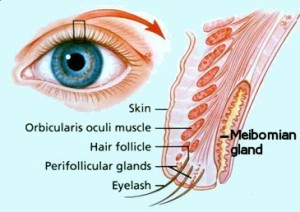Meibomian Gland Dysfunction (MGD) is sometimes also called blepharitis. It is easily the most common cause of dry eyes.
MGD refers to inflammation of the eyelids. It leads to:
- red, flaky skin on the eyelids
- sore, red, gritty eyes.
- eyelids often stuck together in the morning on awakening.
MGD leads to dry eyes by reducing the quality of your tears and causes dry areas on the surface of your eye.
|
|
Each eyelid contains a row of meibomian glands. They produce oil which is very important to proper functioning of the tears. In MGD, the oily secretions become thick and viscous so very little is released into the tear film. The tear film then becomes unbalanced and ineffective in moisturising the eyes and leads to dryness, blurred vision, redness and pain. |
| The layer of tears that is deficient in MGD is the outermost layer. This layer is made of oil, which is secreted by the meibomian glands. The meibomian glands are located in the upper and lower eyelids. Treatment of your meibomian gland dysfunction will help to restore all of the layers of the tear film to a normal healthy state so that you can return to having comfortable eyes again.
E>Eye intense pulsed light therapy is currently the best treatment for MGD. Call today for a dry eye assessment consultation on 03 9583 0855. |

